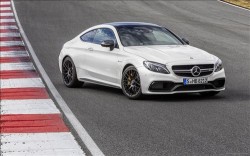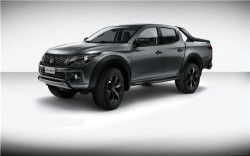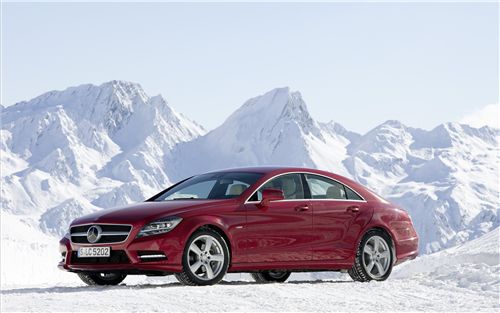Mercedes Benz has been offering 4MATIC systems on nearly 50 models. The 4MATIC powertrain fitted in Mercedes-Benz passenger cars is one of the best-performing permanent all-wheel drive systems on the market.
For the first time, the Mercedes CLS gets the 4MATIC permanent all-wheel drive. The CLS series is known for its driving dynamics and addition of the 4MATIC makes CLS driving even more fun and dynamic.
The tenth all-wheel drive model series from the pioneer: 4MATIC permanent all-wheel drive for the CLS for the first time
Stuttgart/Hochgurgl – For years now, Mercedes-Benz has been successful as a 4x4 manufacturer in the premium segment. Production has soared since the launch of the M-Class in 1997. Today, Mercedes-Benz offers nearly 50 models with 4MATIC across ten model series.
One of the fundamental factors in its success is the formidable performance of the 4MATIC drive concept on snow-covered or icy roads, with its high traction reserves, excellent directional stability, peerless safety and exceptional comfort levels.
The new CLS is capitalising on these benefits too. For the first time, the four-door coupé is available with all-wheel drive in the guise of the CLS 350 CDI 4MATIC BlueEFFICIENCY and CLS 500 4MATIC BlueEFFICIENCY. Besides the CLS, the 4MATIC Workshop being staged in extreme winter conditions on the Timmelsjoch high alpine road in Austria also features the current versions of the S-, CL- and R-Class.
As with the 4MATIC system's set-up on a dry or wet road, directional stability and, therefore, active safety are paramount at all times when wintry conditions prevail, too. The mechanical principle of the 4MATIC system featuring a 45:55 torque split between the front and rear axles and the multi-disc limited- slip centre differential with a basic locking torque of 50 Nm offer all the right ingredients. This basic design enables high levels of traction, as the dynamic shift in axle load toward the rear axle that occurs during acceleration is harnessed to deliver more drive torque to the rear wheels. However, the multi-disc differential lock is also able to shift the drive torque between the front and rear axles, varying the split as the road conditions dictate. Consequently, intervention by the ESP®, 4ETS or ASR electronic control systems can be delayed for as long as possible and the bulk of the drive torque converted into tractive power, even on slippery roads. All control system interventions go virtually unnoticed, yet drivers still know straight away if they are driving on the limit: in such instances, a yellow warning symbol flashes in the instrument cluster as a highly visible prompt to adapt their driving style to the road conditions.
The drive mechanism's permanently engaged design offers key advantages over other systems that first need to diagnose a lack of grip before activating the all-wheel drive. The 4MATIC system on Mercedes-Benz models will have already made use of this valuable time to start transmitting drive torque via the wheels to the road.
4MATIC: stable handling on snow and ice
When pulling away in wintry conditions, the 4MATIC models are designed to develop maximum traction. To this end, certain road conditions are automatically detected and the interventions of the 4ETS electronic traction control system adjusted so as to achieve the greatest possible acceleration while minimising wheel slip, ensuring optimum directional stability in the process. This strategy also allows the vehicle to pull away under the most adverse conditions, such as when one side of the vehicle is on an icy slope (µ-split) or both wheels on either the front or rear axle have limited grip
(µ-jump).
On twisting roads covered with snow and ice, vehicle stability is primarily controlled by the ASR acceleration skid control system's regulation of engine torque. The ASR control thresholds are adjusted according to the driving situation based on the vehicle's longitudinal and lateral dynamic readings as continuously measured by the ESP® sensor system. If vehicle stability is to be maintained, the longitudinal force when cornering must be controlled by means of engine torque regulation in such a way that there are sufficient reserves of lateral force at all times. In order to comply with this physical correlation, when cornering on road surfaces with a low friction coefficient the control thresholds for engine torque regulation at the wheels on the outside of the bend are reduced considerably so that the tyres can develop sufficient lateral force.
4MATIC: cutting-edge technology breaks new ground
The 4MATIC powertrain fitted in Mercedes-Benz passenger cars is one of the best-performing permanent all-wheel drive systems on the market. The basic design concept, with the engine installed longitudinally and the integral transmission and transfer case unit, produces a compact, lightweight arrangement that minimises frictional losses, heralding a number of benefits compared to other passenger car systems with a transverse power unit and selectable 4x4. Depending on the particular model, fuel consumption, for instance, is a mere 0.2 to 0.6 litres more per hundred kilometres than on an equivalent vehicle with conventional drive, while vibration and acoustic comfort meet the high standards expected of Mercedes-Benz vehicles.
CLS 4MATIC: stylish sportiness and dynamism in the winter too
Mercedes-Benz achieves the standard of driving dynamics which the CLS is renowned for courtesy of the highly sophisticated DIRECT CONTROL suspension with adaptive shock absorbers. The weight-optimised DIRECT CONTROL system, featuring a three-link front suspension and multi-link independent rear suspension, automatically adapts to the changing driving situation by varying the damping forces, resulting in a substantial improvement in ride comfort. The air suspension system – optional for the CLS 350 CDI 4MATIC BlueEFFICIENCY and standard on the CLS 500 4MATIC BlueEFFICIENCY – is combined with a continuously variable, electronically controlled damping system that processes a series of sensor signals and controls each wheel individually. So, not only do Mercedes customers experience the best in comfort, they reap the benefits of excellent handling safety and sporty agility too.





































































